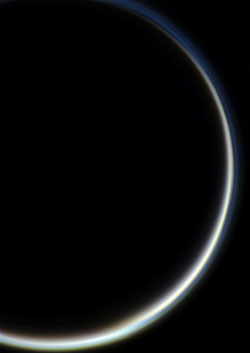Made from one of the most recent Cassini images, this is a color-composite showing a backlit Titan with its dense, multi-layered atmosphere scattering sunlight in different colors. Titan’s atmosphere is made up of methane and complex hydrocarbons and is ten times as thick as Earth’s. It is the only moon in our solar system known to have a substantial atmosphere.
 The Astronomical Research Center (A.R.C) mentioned that Titan’s high-level hydrocarbon haze is nicely visible as a pale blue band encircling the moon.
The Astronomical Research Center (A.R.C) mentioned that Titan’s high-level hydrocarbon haze is nicely visible as a pale blue band encircling the moon.
At 3,200 (5,150 km) miles wide, Titan is one of the largest moons in the solar system – even larger than Mercury. Its thick atmosphere keeps a frigid and gloomy surface permanently hidden beneath opaque clouds of methane and hydrocarbons.
This image was made from three raw images acquired by Cassini on December 13. The raw images were in the red, green and blue visible light channels, and so the composited image you see here approximates true color.
This particular flyby of Titan (designated T-79) gave Cassini’s instruments a chance to examine Titan in many different wavelengths, as well as map its surface and measure its atmospheric temperature. Cassini passed by the giant moon at a distance of about 2,228 miles (3,586 kilometers) traveling 13,000 mph (5.8 km/sec). Read more on the flyby page here.
Credit: NASA / JPL / Space Science Institute. Edited by Jason Major.